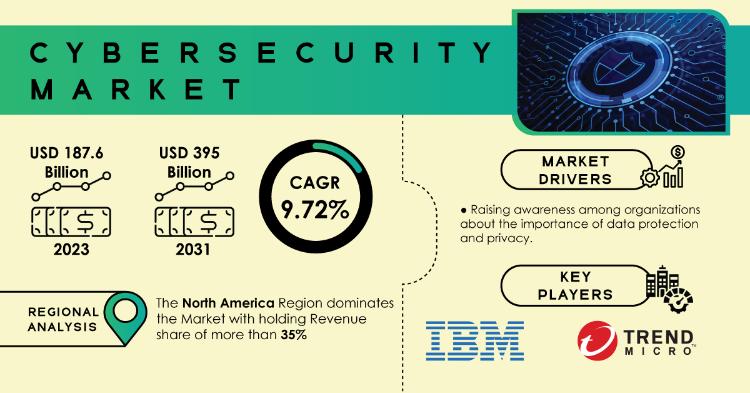Cybersecurity Market Analysis and Insights | Industry Overview
Cybersecurity Market Analysis and Insights | Industry Overview
|
Cybersecurity Market Report Scope and Overview In an increasingly digital world, cybersecurity has become a critical imperative for organizations across industries. As cyber threats evolve in sophistication and scale, businesses are investing heavily in cybersecurity solutions to protect their data, infrastructure, and reputation from cyberattacks, data breaches, and other security incidents. The Cybersecurity Market Report provides a comprehensive analysis of the global cybersecurity landscape, highlighting key trends, challenges, opportunities, and emerging technologies shaping the future of cybersecurity. Market Analysis The Cybersecurity Market is witnessing robust growth driven by the escalating threat landscape, regulatory compliance requirements, digital transformation initiatives, and increasing awareness of cybersecurity risks. Cyberattacks, such as ransomware, phishing, malware, and insider threats, continue to pose significant challenges to organizations of all sizes, prompting them to prioritize cybersecurity investments to safeguard their digital assets and operations. Get a Sample Report of Cybersecurity Market @ https://www.snsinsider.com/sample-request/1242 
Key drivers of growth in the Cybersecurity Market include:
The Cybersecurity Market encompasses a wide range of solutions and services, including network security, endpoint security, cloud security, identity and access management (IAM), security analytics, threat intelligence, and managed security services. Leading cybersecurity vendors offer comprehensive portfolios of products and services designed to protect organizations from a diverse array of cyber threats and vulnerabilities. Market Segmentation and Sub-Segmentation Included Are: By Offering
By Organization Size
By Solution Type
By Deployment Mode
By Security Type
By Verticals
Competitive Landscape The competitive landscape of the Cybersecurity Market is characterized by a diverse ecosystem of vendors, including multinational cybersecurity firms, pure-play cybersecurity vendors, IT security companies, managed security service providers (MSSPs), and emerging startups. Leading cybersecurity vendors such as Palo Alto Networks, Cisco Systems, Check Point Software Technologies, and Fortinet dominate the market, offering a broad range of cybersecurity solutions and services to organizations worldwide. Pure-play cybersecurity vendors specializing in specific areas such as endpoint security, threat intelligence, or cloud security are also gaining traction in the market, leveraging their expertise and innovation to address niche cybersecurity challenges. Managed security service providers (MSSPs) offer organizations outsourced cybersecurity services, including threat monitoring, incident response, and security operations center (SOC) services, enabling organizations to augment their cybersecurity capabilities and improve threat detection and response. Major vendors in the global cybersecurity market include IBM, Cisco, Check Point, FireEye, Trend Micro, Norton LifeLock, Rapid7, Micro Focus, Microsoft, Amazon Web Services, Oracle, Fortinet, Palo Alto Networks, Accenture, McAfee. Strategic partnerships, acquisitions, and investments in research and development are driving innovation and consolidation in the cybersecurity market as vendors seek to expand their product portfolios, enter new markets, and gain a competitive edge. As organizations prioritize cybersecurity as a strategic imperative, the demand for integrated, scalable, and adaptive cybersecurity solutions is expected to continue to rise, driving further innovation and investment in the market. Regional Outlook The Cybersecurity Market exhibits a global presence, with significant growth opportunities in key regions such as North America, Europe, Asia-Pacific, Latin America, and the Middle East and Africa. North America remains the largest market for cybersecurity, driven by the presence of leading technology companies, financial institutions, government agencies, and critical infrastructure providers. Europe is also a major market for cybersecurity, with strong demand from industries such as banking, healthcare, and manufacturing. Asia-Pacific is witnessing rapid growth in cybersecurity investment, fueled by factors such as the digitalization of economies, regulatory reforms, and increasing awareness of cybersecurity risks. Latin America and the Middle East and Africa are emerging markets with growing demand for cybersecurity solutions to address cyber threats, protect critical infrastructure, and enhance national security. Each region presents unique opportunities and challenges for cybersecurity vendors and organizations, influenced by factors such as regulatory environment, technological infrastructure, cybersecurity maturity, and threat landscape. As organizations across industries and regions prioritize cybersecurity as a strategic imperative, the global Cybersecurity Market is expected to experience sustained growth and evolution. Opportunities for Market Growth The Cybersecurity Market presents several opportunities for growth and expansion:
By capitalizing on these opportunities, cybersecurity vendors and organizations can enhance their cybersecurity posture, mitigate cyber risks, and protect their digital assets and operations from evolving cyber threats. Conclusion In conclusion, the Cybersecurity Market represents a critical and dynamic ecosystem that is central to safeguarding organizations from cyber threats, data breaches, and security incidents. With its potential to protect digital assets, ensure regulatory compliance, and safeguard business continuity, cybersecurity has become a strategic imperative for organizations across industries and regions. The market is characterized by rapid innovation, intense competition, and significant investment as organizations seek to stay ahead of evolving cyber threats and protect their digital assets and operations. By leveraging advanced technologies, adopting best practices, and fostering collaboration, cybersecurity vendors and organizations can enhance their cybersecurity posture, mitigate cyber risks, and build a resilient defense against cyber threats in today's digital age. Table of Contents- Major Key Points
Bethany Stewart
Information & Communication Technology Research Associate |
| Free forum by Nabble | Edit this page |

